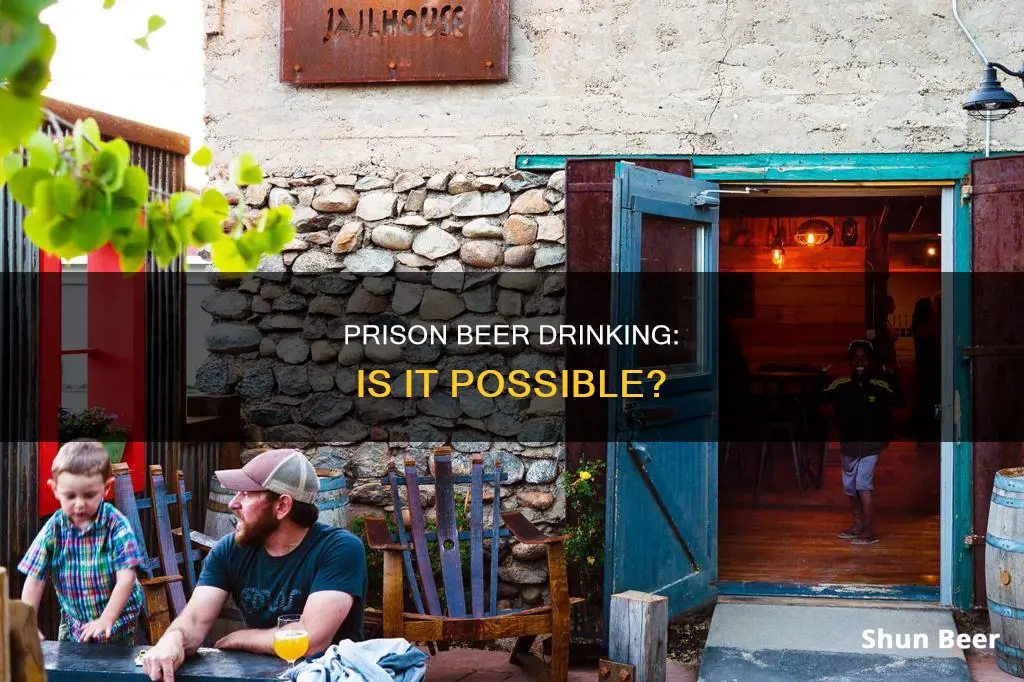
Drinking in prison is a topic that has been popularised by pop culture, with shows like Goodfellas and Orange Is the New Black depicting alcohol consumption behind bars. While these on-screen portrayals may be exaggerated, the reality is that alcohol smuggling and brewing are prevalent in prisons. Inmates have been known to smuggle alcohol in through various means, and they also produce their own alcoholic beverages, known as pruno, hooch, or homebrew, using limited equipment and ingredients available to them. This practice has a long history, dating back to the late 18th century in England, when alcohol was often regulated by those in charge. Today, the production and consumption of alcohol in prisons continue to pose challenges to authorities, leading to creative methods of detection and punishment.
| Characteristics | Values |
|---|---|
| Is drinking beer/alcohol in prison allowed? | No, inmates are not permitted to have alcoholic beverages. |
| How do inmates drink alcohol in prison? | Inmates either smuggle alcohol into prison or make their own alcoholic beverages. |
| What are the common ingredients used to make alcohol in prison? | Apples, oranges, fruit cocktail, fruit juices, hard candy, sugar, high fructose syrup, and possibly other ingredients, including crumbled bread. |
| What is the common name for the alcohol made in prison? | Pruno, prison hooch, or prison wine |
| What equipment is used to make pruno? | Plastic bag, hot running water, and a towel or sock to conceal the pulp during fermentation. |
| What is the alcohol content of pruno? | Depending on the time spent fermenting, the sugar content, and the quality of the ingredients and preparation, pruno's alcohol content by volume can range from 2% to 14%. |
| What are the risks associated with drinking pruno? | Botulism outbreaks have been reported due to the use of potatoes in making pruno. |
| How do correctional officers deal with pruno? | Correctional officers confiscate pruno whenever they find it, and some wardens have banned all fresh fruit, fruit juices, and fruit-based food products from prison cafeterias to eradicate pruno. |
What You'll Learn

Inmates make their own alcohol, known as pruno, hooch, or homebrew
Inmates are not allowed to drink beer or any other alcoholic beverages in prison. However, they have been known to make their own alcohol, known as pruno, hooch, or homebrew.
Pruno is made from a variety of ingredients, including apples, oranges, fruit cocktail, fruit juices, hard candy, sugar, high-fructose syrup, and crumbled bread. The bread contains yeast, which is necessary for the pruno to ferment. Inmates typically use a plastic bag to mix the ingredients and hot running water to conceal the pulp during fermentation. They hide their brew under bunks, inside toilets, inside walls, trash cans, or anywhere else they feel is safe from correctional officers.
The alcohol content of pruno can vary depending on the time spent fermenting, the sugar content, and the quality of the ingredients and preparation. It can range from as low as 2% to as high as 14%. The more sugar that is added, the greater the potential for a higher alcohol content. However, beyond a certain point, the waste products of fermentation cause the yeast to die or go dormant, which also negatively affects the taste of the final product.
Making pruno can be dangerous, as there have been outbreaks of botulism among inmates in several prisons. These outbreaks have been attributed to potatoes used in making the brew. In an effort to prevent the production of pruno, some wardens have banned all fresh fruit, fruit juices, and fruit-based food products from prison cafeterias. However, inmates are still able to make pruno from alternative ingredients, such as sauerkraut and orange juice.
The process of making pruno is relatively simple and only requires basic household items and ingredients. Inmates start by creating a "kicker" or "motor", which is a mixture of fruit and sugar. They then add water or juice and put the mixture into a container such as a trash bag, bucket, or empty bottle. The container is sealed and left to ferment for about a week, with the pressure being released once a day to prevent explosion. Finally, the liquid is strained and consumed.
Beer and Creatine: Mixing Alcohol and Supplements
You may want to see also

Pop culture references to prison drinking
Drinking in prison is a common theme in pop culture, with various references in TV shows and films.
In Goodfellas, Henry arrives at prison dinner with a large bag of smuggled goods, including Scotch and wine. This is a reference to the historical practice of prisoners being able to purchase alcohol, and the opportunity to profit from less powerful inmates.
In Orange Is the New Black, Poussey is known for brewing her own alcohol, or "toilet hooch", which she makes from a mix of "Kool-Aid, old fruit, ketchup and mouldy bread". She gifts this to her fellow inmates, but also turns down an offer to monetise her craft.
In reality, the practice of drinking in prison is similar to pop culture references. Inmates smuggle alcohol in through various means, or brew their own, known as "pruno", "hooch" or "homebrew". In the past, alcohol was regulated and sold by those in charge of prisons, and prisoners were able to purchase it themselves.
Draught Beer: How Does It Work?
You may want to see also

Alcohol as a commodity in prisons
Alcohol has long been a valuable commodity in prisons, with its presence and consumption driven by a range of factors, including social, economic, and psychological motivations. In the late 18th century in England, prisons were often self-financing operations, with jailers deriving income from fees charged to prisoners for various services. Alcohol, in the form of beer, was one such commodity that jailers could sell to prisoners. This dynamic established alcohol as a form of currency within the prison system, where it could be used to purchase goods or exert power over other inmates.
Over time, the methods of obtaining alcohol in prisons have evolved. In modern times, prisoners have become adept at producing their own alcoholic beverages, often referred to as "pruno," "hooch," or "homebrew." These drinks are typically made from a combination of fruits, juices, sugars, and other available ingredients, such as bread, hard candy, or even ketchup. The process involves fermenting the mixture, often in plastic bags or other containers, and hiding it from correctional officers. The quality and alcohol content of these prison-made drinks can vary significantly, with potential alcohol levels ranging from 2% to 14%.
The production and consumption of pruno carry various risks. The use of certain ingredients, such as potatoes, has been linked to botulism outbreaks in prisons. Additionally, the process of fermentation can be unpredictable, leading to potential issues with taste and alcohol potency. The very act of producing and possessing pruno is illegal in prisons, and inmates risk confiscation, loss of privileges, or even extended sentences if caught. Despite these risks, the production and consumption of pruno continue to occur due to the desire for alcohol and the potential profits that can be made from its trade.
The economic aspect of alcohol in prisons cannot be understated. For prisoners with limited resources, producing and selling alcohol can be a lucrative enterprise. It can provide a means of generating income, which can then be used to purchase other goods or services within the prison system. This dynamic can lead to complex social hierarchies and power dynamics among inmates, with those who control the production and distribution of alcohol wielding significant influence over others.
In conclusion, alcohol remains a significant commodity in prisons, driven by a combination of social, psychological, and economic factors. While the methods of obtaining alcohol have evolved over time, the presence of alcohol continues to shape the social and power dynamics within the prison system, presenting challenges to prison authorities and offering opportunities for inmates to exert influence and generate income.
Breastfeeding and Alcohol: Is Red Beer Safe?
You may want to see also

Botulism outbreaks from pruno
Inmates in US prisons have been known to produce their own alcoholic drinks, known as pruno, hooch, brew, prison wine, or buck. Pruno is made by fermenting fruit, sugar, water, and other common ingredients for several days in a sealed plastic bag. The fruit used can vary, but often includes apples, oranges, grapefruit, peaches, and bananas.
Between 2004 and 2012, there were five outbreaks of botulism in US prisons, caused by the consumption of pruno. These outbreaks resulted in confirmed botulism in 15 inmates, with 11 of them requiring mechanical ventilation.
In July 2004, four inmates from a California state prison in Riverside County were hospitalized with signs and symptoms consistent with clinical botulism, including blurry vision, dysarthria, dysphagia, shortness of breath, and generalized muscle weakness. All four men had reportedly drunk from the same batch of pruno, made with unpeeled potatoes, apples, a peach, jelly, and ketchup.
In May 2005, a 30-year-old male inmate from another California state prison was admitted to the hospital with ptosis, ophthalmoplegia, dysarthria, dysphagia, and upper extremity weakness. He had made and drunk pruno using potatoes.
In 2011, eight maximum-security inmates in Utah developed botulism after drinking pruno, and three required mechanical ventilation.
In 2012, there were two outbreaks of botulism in Arizona prisons, affecting 12 inmates, eight of whom were mechanically ventilated.
Pruno-related botulism accounted for a significant proportion of foodborne botulism cases in the United States in 2011 and 2012. The use of potatoes in the production of pruno has been implicated in these outbreaks, as they are a food historically associated with botulism.
Botulism is a rare but serious illness caused by a toxin (poison) that attacks the body's nerves, leading to difficulty breathing, muscle paralysis, and even death. The toxin is produced by Clostridium botulinum, an anaerobic, spore-forming bacterium commonly found in the environment.
The Magic of Bottoms-Up Draft Beer: How Does It Work?
You may want to see also

Attempts to eradicate pruno by banning ingredients
Prison authorities have attempted to eradicate pruno by banning ingredients used in its production. Pruno, also known as prison hooch or prison wine, is an improvised alcoholic beverage made by prisoners using whatever ingredients they can find, such as fruit juice, bread crusts, sugar, and water. The process of making pruno involves fermentation, which requires yeast. While commercial yeast is ideal, prisoners often use bread as a source of natural yeast.
In an effort to stop the production of pruno, some prison wardens have gone to great lengths, including banning all fresh fruit, fruit juices, and fruit-based food products from prison cafeterias. However, these measures have not always been successful, as prisoners have found alternative ingredients, such as sauerkraut and orange juice, to make pruno.
Prisoners' creativity and resourcefulness in making pruno highlight their determination to access alcohol despite the restrictions in prison. The production and consumption of pruno carry risks, including the possibility of contracting deadly bacteria like Clostridium botulinum, which causes botulism, a form of food poisoning that can be fatal.
The attempts to eradicate pruno by banning ingredients demonstrate the ongoing cat-and-mouse game between prison authorities and inmates, with prisoners constantly adapting to find new ways to produce this illicit beverage.
Freezing Beer: Is It Still Drinkable?
You may want to see also
Frequently asked questions
Drinking beer in prison is prohibited. However, inmates have been known to make improvised alcoholic beverages, commonly known as "pruno", "hooch", or "homebrew", using limited equipment and ingredients such as fruit, juice, sugar, and bread.
Inmates use a variety of ingredients, including fruit, juice, sugar, and bread, to ferment their own alcohol. This process can be done using a plastic bag, hot running water, and a towel or sock to conceal the mixture during fermentation.
In addition to the risk of discovery by correctional officers, pruno carries health risks due to the potential for botulism outbreaks. In 2004 and 2005, botulism outbreaks were reported in two California prisons, likely due to the use of potatoes in the pruno production.







